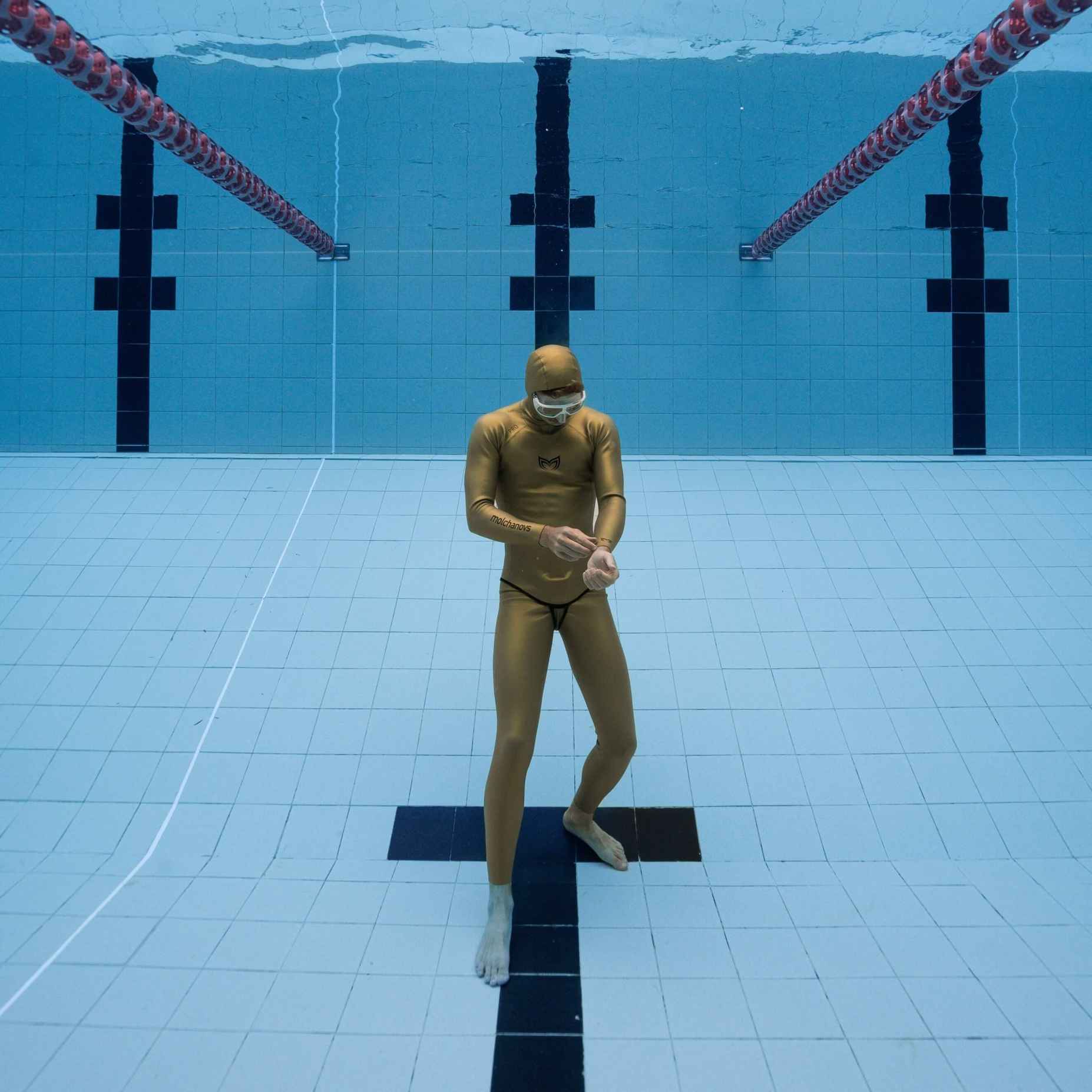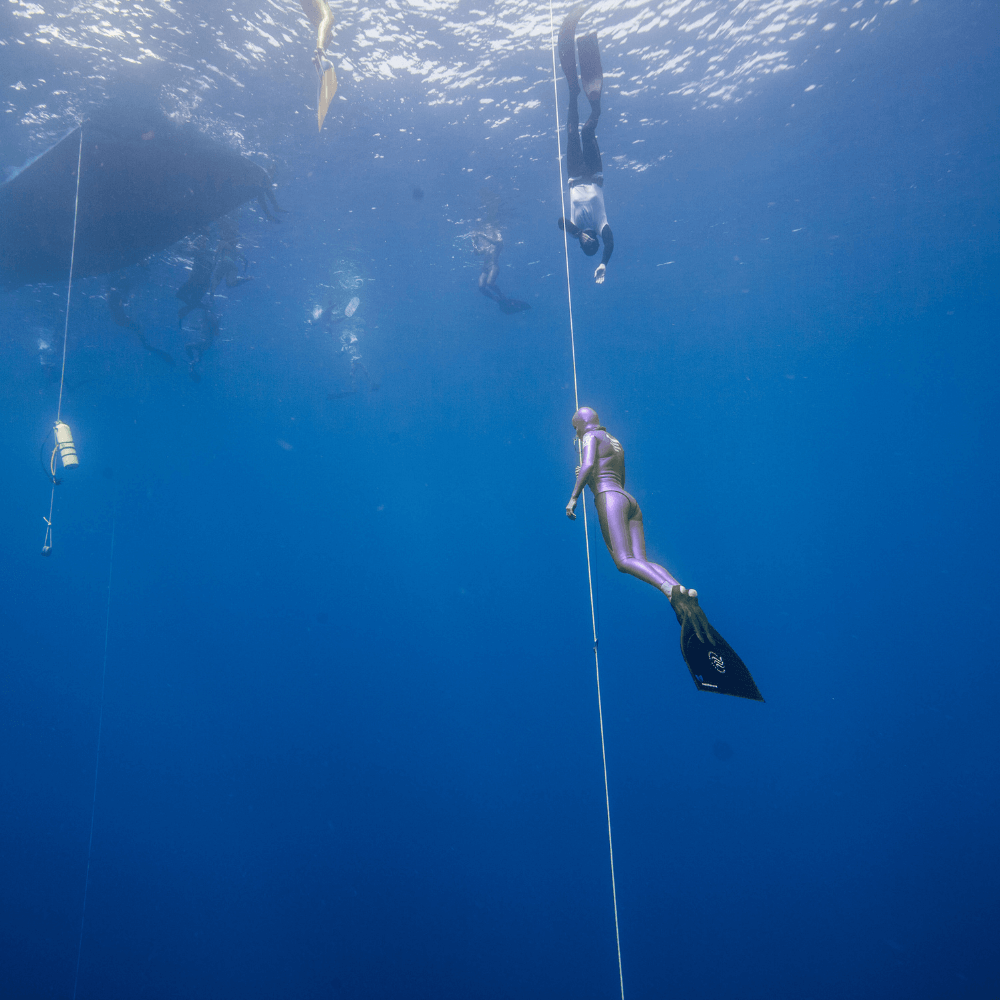Freediving Know-How: What Type of Wetsuit Should I Buy?

The right wetsuit transforms your freediving training. Here's how to choose yours.
By Kristina Zvaritch
Contributors: Alexey Molchanov, Alisa Root & Deena Lynch
Photo © @mochifreediving_
Freedivers wear wetsuits for a lot of reasons: to keep from getting cold, as protection against the sun and jellyfish stings, and to give them better glide in the water (especially in the pool). However, as soon as you start Googling, you’ll find many wetsuit variations — it can feel impossible to understand which one is the right choice! The type of wetsuit, materials used, fit, and thickness all contribute to what makes a wetsuit perfect for your needs.
It's a lot of information, but we've got you covered! Keep reading to learn the ins and outs of shopping for a freediving wetsuit.
The Right Type Of Freediving Wetsuit
The first item to narrow down your search for a wetsuit is the type, or style of wetsuit, that matches the activity you're doing.
Rash Guard or Lycra Suit
 The UPF 50 Rashguard offers basic protection in tropical waters, featuring extended sleeves to shield your hands from harmful UV rays. Photo © @andac.kazar
The UPF 50 Rashguard offers basic protection in tropical waters, featuring extended sleeves to shield your hands from harmful UV rays. Photo © @andac.kazar
If you’re diving in warm, tropical waters, you've probably already seen people diving in a rash guard or Lycra suit. While these suits are easy to put on and take off, be warned that they don’t offer any thermal insulation — that means you’ll get cold relatively quickly, depending on your activity level and the water temperature! These suits also don’t provide complete protection against jellyfish stings or scratches from rocks and coral. While rash guards or stinger suits are great for basic protection, make sure to also check that it has an Ultraviolet Protection Factor (UPF) rating of at least 50+ for maximum sun safety, like the Molchanovs UPF 50 Rashguard.
Scuba Wetsuits
While you can find some inexpensive scuba wetsuits with fairly good thermal insulation, using one for freediving has several drawbacks. First of all, scuba wetsuits use more dense neoprene to resist compression at depth. Second, they also use stiff nylon to protect against general wear and tear — this combination makes the material less flexible and affects your mobility while freediving (think free immersion and no-fins disciplines!). And third, scuba wetsuits also have zippers, allowing water to seep in; this won’t feel good if you’re diving in colder waters!
Surf Suits
Since surfers spend most of their time at the surface, the neoprene in surf-specific wetsuits is less dense and not built to withstand repetitive compression at depth. So, while surf suits are more flexible than scuba wetsuits, they compress much quicker than scuba or freediving wetsuits. The zippers often found on surf suits can also give freedivers the same trouble as scuba wetsuits (water seeping in). Plus, the extra padding in the chest and abdominal area of surf suits can be restrictive when you take a full breath.
Freediving Wetsuits
 It's essential to choose a freediving-specific wetsuit for full range of movement. Photo © @ohchanovsjunior
It's essential to choose a freediving-specific wetsuit for full range of movement. Photo © @ohchanovsjunior
Freediving wetsuits use neoprene specifically designed for freediving and prioritize range of movement (perfect for every discipline!). Its density is somewhere between scuba and surfing wetsuits — dense enough to withstand compression at depth, yet not so dense that flexibility and mobility are compromised. They come in one-piece and two-piece variations, but the two-piece style is usually more popular as it includes a hood, giving you extra warmth in cooler waters. What’s more, freedivers have the option to wear just the top if they feel overheated in the water!
Molchanovs Wetsuits
Did you know that Molchanovs offers three lines of equipment (which include wetsuits) for every type of freediver?
CORE: The CORE line offers top-quality, comfortable, and affordable gear for everyday freediving. It's built to last and look good — perfect not only for recreational freedivers, but also snorkelers, surfers, scuba divers, and other water sports enthusiasts!
SPORT: The SPORT line blends top-quality materials with affordability to maximize comfort and deliver outstanding performance. It’s designed for those looking to make freediving part of their everyday life.
PRO: The PRO line uses premium materials for the best performance in the industry. PRO line gear is specifically designed for freediving professionals and athletes who want elite-level equipment.
But what about wetsuit materials?
A Question Of Fabric: Freediving Wetsuit Materials
Wetsuits use terminology like "lined," "smooth skin," "open cell," and more. Let's familiarize ourselves with what each of these materials means.
Double-Lined
 The two-piece SPORT Wetsuit Double-Lined is a popular choice for lifestyle freedivers for its durability. Photo © novak.family.
The two-piece SPORT Wetsuit Double-Lined is a popular choice for lifestyle freedivers for its durability. Photo © novak.family.
Double-lined wetsuits are made of neoprene and have a lining on both the inside and outside of the wetsuit for more durability. These are great wetsuits for beginners as they’re more durable than wetsuits made from other materials, especially since beginners may struggle with putting them on without damaging them.
Benefits:
- Durable against tears and scrapes
- Easy to put on and take off
- Doesn’t stretch out over time
Things to consider:
- Thermal insulation is diminished if the wetsuit is not properly fitted
- Less flexible
The CORE One-Piece Wetsuit is both durable and easy to wear — excellent for beginners who are exploring the sport! Lifestyle freedivers who want the same features in a two-piece wetsuit should check out the SPORT Wetsuit Double-Lined.
Single Lining Outside – Also Known As Open-Cell
 The SPORT Wetsuit Outside-Lined provides thermal insulation for cooler waters. Photo © @mattfreediver
The SPORT Wetsuit Outside-Lined provides thermal insulation for cooler waters. Photo © @mattfreediver
Wetsuits with lining on the outside are often referred to as "open cell wetsuits," meaning that the unlined side has exposed open neoprene cells, keeping you warm in cooler waters. Wetsuits with an exterior lining are very popular among recreational freedivers.
Benefits:
- Good thermal insulation due to the open-cell interior
- More durable against accidental scrapes due to the lined exterior
- More flexible for freedom of movement
Things to consider:
- Requires lubrication to put on due to the open-cell interior
- Can also be put on in-water
- If you're using liquids other than eco-friendly soap, rinse the inside of the wetsuit while you are wearing it to flush out chemicals that are harmful to the ocean
- Open-cell interior is prone to tears from long nails
Take a look at the SPORT Wetsuit Outside-Lined, which provides more warmth in cooler waters and freedom of movement.
Single Lining Inside – Also Known As Smooth-Skin Outside
 The PRO Wetsuit Inside-Lined gives you unmatched glide in the pool and open water. Photo © brodiewmedia.
The PRO Wetsuit Inside-Lined gives you unmatched glide in the pool and open water. Photo © brodiewmedia.
Wetsuits with lining on the inside are often referred to as "smooth skin" wetsuits by freedivers, which describes the outside of the wetsuit. The open cells of the neoprene on the outside of the suit are smoothed over and closed with a special treatment, leaving the surface very hydrodynamic — perfect for long glides underwater! This type of wetsuit is prized by competitive freedivers, who need the least amount of drag on their dives.
Benefits:
- Preferred choice among athletes
- Flexible, allowing for freedom of movement
- Hydrodynamic due to the smooth skin
- Easy to put on and remove on dry land
Things to consider:
- Fragile and vulnerable to tears and scrapes
- Will crack over time due to UV rays
 The PRO Wetsuit Inside-Lined is the top choice for pro athletes as a competition wetsuit. Photo © @daanverhoevenfreediver
The PRO Wetsuit Inside-Lined is the top choice for pro athletes as a competition wetsuit. Photo © @daanverhoevenfreediver
For a premium wetsuit designed for competitive performance and unmatched glide, check out the PRO Wetsuit Inside-Lined. Freedivers who want a more affordable wetsuit for training and performance can choose the SPORT Wetsuit Inside-Lined.
Unlined – Also Known As Smooth Skin Open Cell Wetsuit
 The PRO Wetsuit Unlined is designed for performance-focused freediving in colder waters. Photo © @markina_ol
The PRO Wetsuit Unlined is designed for performance-focused freediving in colder waters. Photo © @markina_ol
A wetsuit with no lining has smooth skin on the outside and open cell on the inside — freedivers often call it a "smooth skin open cell" wetsuit. This combination allows for more underwater glide while keeping you warm in cold waters. Freediving athletes who are diving in cold waters often choose unlined wetsuits, and those who are diving under ice choose thicker versions of the wetsuit!
Benefits:
- Very hydrodynamic due to the smooth skin
- Good thermal insulation due to the open cell inside
Things to consider:
- Extremely fragile and vulnerable to tears and scrapes
- 5mm and thicker wetsuits are more durable
For freedivers who are making deep performances in colder waters, the PRO Wetsuit Unlined combines a glorious glide with protection against the cold for performance dives.
Sandwich
Sandwich wetsuits include a layer of elastic nylon sandwiched between open cell on the inside and smooth skin on the outside. A sandwich wetsuit isn’t very common among freedivers due to some specific drawbacks.
Benefits:
- More durable than a wetsuit with no lining
- Doesn’t stretch out over time
- Very hydrodynamic due to the smooth skin
Things to consider:
- Less stretchy than wetsuits with no lining due to heavy use of glue
- Very vulnerable to tears and scrapes
One-Piece Freediving Wetsuits
 The CORE One-Piece Wetsuit is an excellent choice for beginner freedivers.
The CORE One-Piece Wetsuit is an excellent choice for beginner freedivers.
One-piece freediving wetsuits are typically lined on the inside, with either lining or smooth skin on the outside. While they’re similar in looks to scuba wetsuits, they use a different type of neoprene and include a cut that seals more efficiently at the collar and allows more flexibility and movement! In competitive freediving, these types of wetsuits are more common in the pool (but top athletes also can use them for depth) as they are thinner (1 - 2mm), have less need for thermal insulation, and have more glide due to the smooth skin exterior.
Benefits:
- Hydrodynamic
- Less buoyant due to minimal thickness and lack of a hood
- Less neoprene than a two-piece wetsuit
Things to consider:
- Decreased thermal insulation
- Lack of a hood
- Thinner neoprene
- Zipper
For beginners, the Molchanovs CORE One-Piece Wetsuit 2.5mm is designed for comfort, durability, and an easy-to-wear wetsuit that can be used for all water sports.
Choose The Right Thickness: Wetsuits And Water Temperature
The thermal conductivity of water is about 25 times higher than that of air, so even in the warmest water, you’ll eventually get cold. Wearing a wetsuit slows down heat loss, though! If you’re not sure which thickness to get based on water temperature, check out the table below for general recommendations based on a one-hour freediving session may vary from person to person depending on how quickly you get cold in the water.
| Temperature Range | Wetsuit Thickness |
| 28°C (82°F) and warmer | 1 - 1.5mm |
| 24 - 28°C (75 - 82°F) | 3mm |
| 18 - 24°C (64 - 75°F) | 5mm |
| 16 - 17°C (61 - 63°F) and colder | 7mm |
It's important to choose the thinnest possible wetsuit while still ensuring enough thermal insulation. Thicker wetsuits come with heavier weights, which means that you will be more negative at depth due to the amount of neoprene compression compared to a thinner wetsuit with fewer added weights.
Do I Need Socks And Gloves?
Wearing socks and gloves is essential when diving in cold waters since your hands and feet get cold first. Socks and gloves are usually double-lined or have open cell inside and Lycra outside, but experienced freedivers may opt for smooth skin on the outside.
Size Matters: Standard-Size Or Custom Wetsuits
 A freediving wetsuit should fit your body like a glove to keep you warm and give you complete mobility underwater. Photo © @markina_ol
A freediving wetsuit should fit your body like a glove to keep you warm and give you complete mobility underwater. Photo © @markina_ol
If you are of typical body proportions and are using your wetsuit purely for recreational freediving, a standard-size wetsuit may be a suitable option for you! Before you buy one, make sure to try on the wetsuit if possible or check the measurements on the manufacturer’s website. Get a friend to measure you while you’re wearing your swimsuit. If you’re between sizes, consider investing in a custom-fit wetsuit, especially for 5 - 7mm wetsuits.
If you are not of typical proportions or just want a wetsuit with a perfect fit, choose a custom wetsuit. Have someone take your measurements (while you’re wearing your swimsuit) as directed by the manufacturer and make sure to double- and triple-check them afterward! Some custom add-ons targeted towards spearfishers may be available, such as reinforced knees, reinforced elbows, knife pockets, and loading pads for spearguns.
How To Take Care Of Your Freediving Wetsuit
Make sure that after you invest in a wetsuit, you take care of it properly! Here are some tips to extend the life of your wetsuit:
- Thoroughly rinse your wetsuit in freshwater directly after every dive. If you do not have a chance to do so right after diving, leave your wetsuit in a bag with some seawater. Don’t let salt water dry on your wetsuit.
- After rinsing in freshwater, allow your wetsuit to air dry. Don’t dry your wetsuit in the sun, near a fire, near central heating systems, or in a clothes dryer.
- Occasionally, gently hand-wash your wetsuit using a wetsuit-specific shampoo. Follow directions closely. Remove grease, oil, and other stains using a wetsuit-specific degreaser. Never use petroleum products on your wetsuit or put it in a washing machine.
- Store your dry wetsuit in a cool, dry place and avoid folding it for extended periods. While you can fold it for short-term transport, you should lay your wetsuit flat or hang it on a wide hanger that won't stretch the wetsuit when stored for long periods. Avoid storing your wetsuit in direct sunlight.
- If you have to wear a PRO wetsuit for an extended period, we recommend wearing a protective fabric t-shirt over the wetsuit to shield the outer layer.
At Molchanovs, we have every type of wetsuit a freediver needs, even wetsuits for kids — check out our full selection! If you still have questions, feel free to e-mail us at info@molchanovs.com and tell us what your wetsuit needs are and we’ll help you pick the right one.
Want more in-depth information on freediving gear and news on all new releases and sales? Sign up to the Magazine to stay up-to-date on everything freediving!




Leave a comment